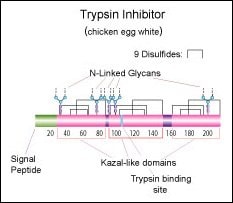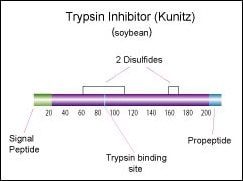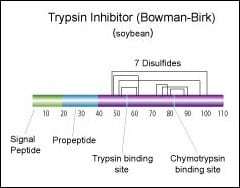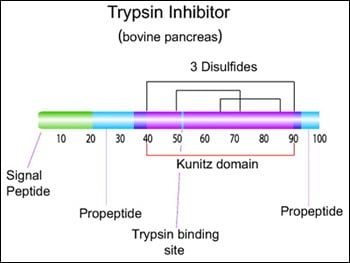Trypsin Inhibitors
Natural trypsin Inhibitors also known as serine protease inhibitors (serpins) are the largest and most diverse family of protease inhibitors.1 Serpins control the activation and catabolism of proteins by the inhibition of serine proteases in vivo.2
There are four natural sources of trypsin inhibitors: bovine pancreas, ovomucoid, soybean, and lima bean. Each inhibitor acts as a competitive substrate analog and binds with its serine protease to form an inactive complex, therefore rendering the protease inactive.3
This process allows the serpin (trypsin inhibitor) to stop the proteolytic activity of the serine protease when its function is no longer necessary.
Trypsin inhibitors provide unique processes depending on their source. For example, inhibitors in the seeds of legumes (soybean and lima bean) act as a feeding deterrent for insects by disrupting midgut proteases. This natural function is being expanded upon in the development of insect resistant transgenic plants. Soybean inhibitors have also been found to contribute to pancreatic hypertrophy in rats, again providing a feeding deterrent. The Bowman-Birk soybean inhibitor is being studied as a cancer preventive agent.4
Products
Synonym: BPTI (basic pancreatic trypsin inhibitor)
M.W.: ~6.5 kDa (single-chain 58-amino acid peptide)
pI: ~10.5
Specific Activity: One mg of trypsin inhibitor will inhibit greater than 1.5 mg of trypsin with activity of ~10,000 BAEE units per mg protein
Derived from New Zealand-sourced pancreas
Solubility: This product is soluble in water (2 mg/mL)
BPTI is a 58 amino acid single polypeptide chain with 3 disulfide bonds.5
BPTI inhibits both bovine and human trypsin, chymotrypsin, kallikrein and plasmin. BPTI does not inhibit porcine elastase.6

Figure 2. T9253 - Trypsin inhibitor from chicken egg white (Type II-O)
Synonym: Ovomucoid
M.W.: ~28 kDa
pI: 4.17
Specific Activity: One mg will inhibit 0.8-1.2 mg of trypsin with activity of ~10,000 BAEE units per mg protein. May inhibit ≤ 0.3 mg of chymotrypsin with activity of approx. 40 BTEE units per mg protein.
Solubility: This product is soluble in 0.67 M phosphate buffer, pH 7.6 (2 mg/mL).
Chicken ovomucoid is a major glycoprotein that inhibits bovine trypsin. It is comprised of 186 amino acids that are arranged in three tandem domains.8 Each domain contains three disulfide bonds, two tyrosine residues, and one active site.9 Ovomucoid is described as a single headed inhibitor of trypsin, meaning each ovomucoid molecule binds 1:1 with trypsin.7
This product contains some ovoinhibitor. Ovoinhibitor is another protease inhibitor from chicken egg white. Ovoinhibitor has at least five binding sites, and is responsible for the inhibition of bovine trypsin, bovine chymotrypsin and porcine elastase.10 Trypsin and chymotrypsin comprise 2 binding sites each, while the last site binds elastase.11 Ovomucoid and Ovoinhibitor are the two most abundant protease inhibitors in chicken egg white, comprising 11 and 1.5% of the protein.12
T2011 - Trypsin inhibitor from chicken egg white
Type III-O (free of ovoinhibitor)
Synonym: Ovomucoid
M.W.: ~27 kDa
Specific Activity: One milligram of product will inhibit 1.0-2.0 mg of trypsin with activity of ~10,000 BAEE units/mg protein
Solubility: This product is soluble in 0.67 M phosphate buffer, pH 7.6 (2 mg/mL)
This product has the same characteristics as described above for product T9253, but is further purified by an ammonium sulfate cut and filtration process to eliminate the ovoinhibitor. The absence of ovoinhibitor results in an even more pure ovomucoid that continues to inhibit trypsin in a 1:1 complex.
T4385 - Trypsin inhibitor from turkey egg white
Type II-T
Synonym: Turkey Ovomucoid
M.W.: ~20 kDa
Specific Activity: One mg will inhibit 0.9-1.3 mg of trypsin with activity of ~10,000 BAEE units per mg protein or 0.4-1.0 mg of α-chymotrypsin with activity of ~40 BTEE units per mg protein
Solubility: This product is soluble in 0.67 M phosphate buffer, pH 7.6 (1 mg/mL)
Trypsin inhibitor from turkey egg white contains two independent binding sites, one for bovine trypsin and the other for α-chymotrypsin. At low ph (2.0) a third domain (OMTKYT3) develops and inhibits most serine proteases that prefer a neutral complex site.13
Kunitz and Bowman-Birk (BBI) Soybean Protease Inhibitors
These two proteins are the most abundant protease inhibitors in soybeans. BBI with a molecular mass of 8 kDa is a strong inhibitor of both trypsin and chymotrypsin and contains independent binding sites for each. The Kunitz inhibitor with a molecular mass of 20.1 kDa, comprises one binding site that strongly inhibits trypsin while weakly binding chymotrypsin.

Figure 3.Trypsin inhibitor from Glycine max (soybean): Kunitz Inhibitor
Synonyms: Kunitz Trypsin Inhibitor, Tia1, STI and SBTI
M.W.: 20.1 kDa
pI: 4.525
Extinction Coefficient: E1% = 9.94
(280 nm, pH 7.6 buffer)
Soybean trypsin inhibitor was first isolated by Kunitz.14 Several other related inhibitors are also found in soybeans.15 Trypsin inhibitor from soybeans is a monomeric protein containing 181 amino acid residues in a single polypeptide chain cross linked by two disulfide bridges.16-18
Soybean trypsin inhibitor inhibits trypsin, and to a lesser extent chymotrypsin19 and plasmin.20 Soybean trypsin inhibitor will also inhibit other proteases by a mechanism similar to trypsin. SBTI has inhibitory effects towards plasma kallikrein and coagulation Factor Xa. However, Soybean trypsin inhibitor will not inhibit metalloproteases, tissue-based kallikrein, acid proteases, or thio proteases.
Soybean trypsin inhibitor forms a 1:1 stoichiometric complex with the protease active site. Upon formation of this complex, trypsin may cleave a single arginine-isoleucine bond on the inhibitor.21,22 Inhibition is both reversible and pH dependent. Dissociation of this complex may yield a modified or native form of the inhibitor.23 The optimal pH for trypsin binding is 8.0 with an association constant of greater than 109 at pH 8.0 and an association constant 0.15-2.6 x 104 at pH 3.6-4.4.24
T9003 - Trypsin inhibitor from Glycine max (soybean)
Type I-S
This product is chromatographically purified on DEAE Sepharose and contains 10% Sodium phosphate buffer salts, pH 7.6.
Specific Activity: One mg will inhibit 1.0-3.0 mg of trypsin with activity of ~10,000 BAEE units per mg protein.
One chymotrypsin unit will hydrolyze 1.0 µmole of BTEE per min at pH 7.8 at 25 °C.
Solubility: Trypsin inhibitor is soluble in water and phosphate buffers at 10 mg/mL. It is soluble in balanced salt solutions (1 mg/ml) and in serum-free media. Solutions at concentrations higher than 10 mg/ml may be hazy and have a yellow to amber color.
Storage/Stability: This product remains active in frozen aliquots at –20 °C, but freeze-thaw should be avoided. This protein is reversibly denatured by short heating to 80 °C and irreversibly denatured by heating to 90 °C.15
T6522 - Trypsin inhibitor from Glycine max (soybean)
Type I-S
Cell Culture tested
This product is chromatographically purified on DEAE Sepharose and contains 10% Sodium phosphate buffer salts, pH 7.6.
Specific Activity: One mg will inhibit 1-3 mg of trypsin with activity of ~10,000 BAEE units per mg protein
Solubility: Trypsin inhibitor is soluble in water and phosphate buffers at 10 mg/mL. It is soluble in balanced salt solutions (1 mg/mL) and in serum-free media. Solutions at concentrations higher than 10 mg/mL may be hazy and have a yellow to amber color.
Storage/Stability: This product remains active in frozen aliquots at –20 °C, but freeze-thaw should be avoided. This protein is reversibly denatured by short heating to 80 °C and irreversibly denatured by heating to 90 °C.15
T6414 - Trypsin inhibitor from Glycine max (soybean)
This product is a sterile filtered, cell cultured 1x solution (0.1% trypsin inhibitor solution in Dulbecco's PBS), which is appropriate for use in cell culture applications. It has been optimized for passage of endothelial cells.
Storage/Stability: This product remains active in frozen aliquots at –20 °C, but freeze-thaw should be avoided. This protein is reversibly denatured by short heating to 80 °C and irreversibly denatured by heating to 90 °C.15
T9008 - Trypsin inhibitor from Glycine max (soybean) 1% solution in water
For use in cell culture applications
Prepared from T9003, sterile filtered and processed to yield a convenient no buffer solution.
Storage/Stability: This product is stored at 2-8 °C. This solution can also be stored as frozen aliquots at –20 °C, but freeze-thaw cycles should be avoided. This protein is reversibly denatured by short heating to 80 °C and irreversibly denatured by heating to 90 °C.15
T9128 - Trypsin inhibitor from Glycine max (soybean)
Type II-S
Prepared by ammonium sulfate fractionations along with a series of clarification steps to yield a product with 90% protein and 10% Sodium phosphate buffer salts, pH 7.6.
Specific Activity: One mg will inhibit a minimum of 1.0 mg of trypsin with activity of ~10,000 BAEE units per mg protein.
Solubility: This product is soluble in water (1 mg/mL). Solutions at higher concentrations (greater than 10 mg/mL) may be hazy and have a yellow to amber color.
Storage/Stability: This product remains active in frozen aliquots at —20 °C, but freeze-thaw should be avoided. This protein is reversibly denatured by short heating to 80 °C and irreversibly denatured by heating to 90 °C.15
T2327 - Trypsin inhibitor from Glycine Max (soybean)
≥98% Kunitz type inhibitor
Further purified chromatographically from T9128 to yield pure Kunitz Type trypsin inhibitor.
This product contains 10% sodium phosphate buffer salts, pH 7.6.
Specific Activity: One mg will inhibit ≥ 1.6 mg of trypsin with activity of ~10,000 BAEE units per mg protein.
Solubility: Trypsin inhibitor is soluble in water and phosphate buffers at concentrations higher than 10 mg/mL may be hazy and have a yellow to amber color.
Storage/Stability: This product remains active in frozen aliquots at -20 °C, but freeze-thaw should be avoided. This protein is reversibly denatured by short heating to 80 °C and irreversibly denatured by heating to 90 °C.15
Trypsin-chymotrypsin inhibitor from Glycine max (soybean): Bowman-Birk inhibitor

Figure 4.T9777 - Trypsin-chymotrypsin inhibitor from Glycine max (soybean)
Synonym: Bowman–Birk inhibitor (BBI)
CAS Number: 37330-34-0
Unit definition: One trypsin unit will produce a ΔA253 of 0.001 per min with BAEE as substrate at pH 7.6 at 25 °C; reaction volume 3.2 ml, 1 cm light path.
M.W.: 8 kDa29
The Bowman-Birk inhibitor (BBI) from soybean is a monomeric protein containing 71 amino acids in a single polypeptide chain crosslinked by seven disulfide bridges.26 This inhibitor contains two independent inhibitory binding sites, one for trypsin and the other for chymotrypsin.27 BBI binds each protease to form a 1:1 complex. Since the inhibition is non-competitive, BBI has the ability to form a ternary complex with both enzymes.28
This product is chromatographically purified on DEAE Sepharose and contains 20% Sodium phosphate buffer salts, pH 7.6.
Specific Activity: One mg protein will inhibit ≥0.5 mg trypsin with activity of ~10,000 BAEE units per mg protein.
One mg protein will inhibit ≥1.0 mg chymotrypsin with activity of ~40 BTEE units per mg protein.
Solubility: Trypsin-chymotrypsin inhibitor is soluble in water or 0.67 M Sodium phosphate, pH 7.6 (1 mg/mL).
Trypsin inhibitor from Phaseolus limensis (lima bean):
Synonyms: Trypsin Inhibitor from lima beans and LBTI
M.W.: 9 kDa
pI: 4.525
Extinction Coefficient: E1% = 9.94
(280nm, pH 7.6 buffer)
Trypsin inhibitor from lima bean is a monomer comprised of 83 amino acids that has the ability to undergo a concentration-dependent dimerization. The degree of self-association depends upon the type of variant and pH.30
Trypsin inhibitor from Phaseolus limensis has four to six variants whose inhibitory activities towards trypsin are essentially identical; whereas, some differences exist towards inhibition of chymotrypsin. The variant’s amino acid sequences are similar, each containing 7 disulfide bonds.31
Trypsin inhibitor forms a 1:1 stoichiometric complex with the protease active site. The complex of the inhibitor with either trypsin or chymotrypsin has no further inhibitory effect toward more of the same enzyme, but has full activity towards the other enzyme (forming 1:1:1 complex).30,32 This implies that there is one binding site for trypsin and another for chymotrypsin. Trypsin binds to a Lys-Ser site, while chymotrypsin binds to a Leu-Ser site.31 Inhibition is both reversible and pH dependent. Dissociation of this complex may yield a modified or native form of the inhibitor.23 The optimal pH for trypsin binding is 8.0 with an association constant of greater than 109 at pH 8.0, and an association constant of 0.15-2.6 x 104 at pH 3.6-4.4.24
T9378 Trypsin inhibitor from Phaseolus limensis (lima bean)
This product is a lyophilized powder containing 10% Sodium phosphate buffer salts, pH 7.6.
Specific Activity: One mg will inhibit a minimum of 0.8 mg of trypsin with activity of ~10,000 BAEE units per mg protein.
Solubility: Trypsin inhibitor is soluble in water and phosphate buffers at 1 mg/mL. It is soluble in balanced salt solutions and in serum-free media. Solutions at concentrations higher than 10 mg/mL may be hazy and have a yellow to amber color.
Related Products
Cell Culture Application
Trypsin inhibitors are used in cell culture applications to further inhibit tryptic activity during cell dissociation to prevent cell damage/death.
Procedure:
After trypsinizing cells, resuspend cells in 1 mL trypsin inhibitor solution (1 mg/mL using either a balanced salt solution or serum free media) for every mL of trypsin solution used for dissociation. Centrifuge the cell suspension at 1000 rpm for 5 minutes. A cell pellet should form. Remove as much of the trypsin inhibitor as possible and resuspend the pellet in serum-free medium. Culture cells as desired.
Assay Method for Trypsin Inhibitor Activity
The activity of most trypsin inhibitor preparations is determined by a continuous rate spectrophotometric assay and expressed as the inhibition of BAEE units.
Unit Definition: One BAEE unit will produce a ΔA253 of 0.001 per min at pH 7.6 and 25 °C using BAEE as a substrate. Reaction volume = 3.2 mL.
Conditions
Temp = 25 °C, pH = 7.6, A= 253 nm, Light path = 1 cm
In a 3.2 mL reaction mix, the final concentrations are 63 mM sodium phosphate, 0.23 mM Nα-benzoyl-L-arginine ethyl ester (BAEE), 0.002 mM hydrochloric acid, 0.005mg trypsin, and 0.003 - 0.001 mg trypsin inhibitor.
Reagents Needed
S0751 - Sodium Phosphate monobasic
B4500 - Nα-Benzoyl-L-arginine ethyl ester hydrochloride (BAEE)
258148 - Hydrochloric acid ACS reagent
T8003 - Trypsin from bovine pancreas
Reagents
- 67 mM Sodium Phosphate Buffer, pH 7.6 at 25 °C
(Prepare 100 mL in deionized water using Sodium Phosphate, Monobasic, Anhydrous, Product No. S0751. Adjust to pH 7.6 at 25 °C with 1 M NaOH.) - 0.25 mM Nα-Benzoyl-L-Arginine Ethyl Ester Solution (BAEE)
(Prepare 50 mL in Reagent a using Nα-Benzoyl-L-Arginine Ethyl Ester, Hydrochloride, Product No. B4500.) - 1 mM Hydrochloric Acid Solution (HCl)
(Prepare 50 mL in deionized water using concentrated Hydrochloric Acid, Product No. 258148.) - Trypsin Enzyme Solution (Trypsin)
(Immediately before use, prepare a solution containing 1 mg protein/mL of Trypsin, Product No. T8003, in cold Reagent C.) - Trypsin Inhibitor Solution (Inhib.)
(Immediately before use, prepare a solution containing 1.0 mg/mL of Trypsin Inhibitor in cold Reagent A.)
Procedure
Pipette (in milliliters) the following reagents into suitable quartz cuvettes
Part A:
Allow to stand at 25 °C for a minimum of five minutes and no longer than six minutes.
Mix by inversion and pipette (in milliliters) the following reagents into suitable cuvettes:
Part B:
Mix by inversion and equilibrate to 25 °C. Monitor the A253nm until constant, using a suitably thermostatted spectrophotometer. Then add:
Immediately mix by inversion and record the increase in A253nm for approximately 5 minutes. Obtain the ΔA253nm/minute using the maximum linear rate for the Tests, Blank, and Uninhibited Solution.
Calculation
| Trypsin Activity in BAEE units/mL enzyme = | (ΔA253nm/min Test – ΔA253nm/min Blank)(df)(10.0) (0.001)(0.10)(0.5) |
df = Dilution factor
0.001 = The change in A253nm/minute per unit of Trypsin at pH 7.6 at 25 °C in a 3.2 ml reaction mix
0.10 = Volume (in milliliters) enzyme used (Part B)
10.0 = Total volume in milliliters of assay (Part A)
0.5 = Volume (in milliliters) of enzyme used (Part A)
Units/mg solid = |
mg solid/mL enzyme |
Plot the Trypsin activity (BAEE units/mg protein) vs mL of Trypsin Inhibitor/RM
Mg Trypsin Inhibitor = (mL of Trypsin Inhibitor)(Conc. of Trypsin Inhibitor, mg/mL)
Mg Trypsin Inhibited by 1 mg Trypsin Inhibitor = |
mg Trypsin/RM (normalizing factor) mg Trypsin Inhibitor (from plot) |
Normalizing Factor = (BAEE Units of Uninhibited Trypsin per mg solid/10,000 BAEE units of Trypsin per specification.)
Notes:
- This enzyme assay is used to assay product numbers: T9003, T9008, T9128, T9253, T2011, T4385, T9378, and T0256.
- When assaying Trypsin Inhibitor, Type II-S, product number T9128, prepare a solution containing 0.60 mg/mL of Trypsin Inhibitor in cold Reagent a.
- The uninhibited Trypsin activity should be within 85% of the release value for activity.
- With 11,700 to 13,005 Trypsin units/mg solid per label, the acceptable range for activity of the uninhibited Trypsin reaction should be 10,000 to 15,300 Trypsin units/mg solid. This range should also correspond to a corrected ΔAbs253nm/minute of 0.0545 to 0.0835. With this rate and an inhibition of 20% to 80% the ΔAbs253nm/minute should be above the spectrophotometer rate detection limit of 0.0020.
Trypsin Unit Conversions
1 BAEE µM Unit = 200 BAEE Units
1 TAME µM Unit = 0.27 BAEE µM Units
1 BAEE µM Unit = 3.64 TAME Units
1 TAME µM Unit = 55 BAEE A253 Units
1 BAEE A253 Unit = 0.018 TAME µM Unit
1 TAME µM Unit = 180 TAME A247 Units
1 TAME A247 Unit = 0.33 BAEE Units
1 USP Unit = 3.0 BAEE Units
1 NF Unit = 1.1 USP Units
References
To continue reading please sign in or create an account.
Don't Have An Account?